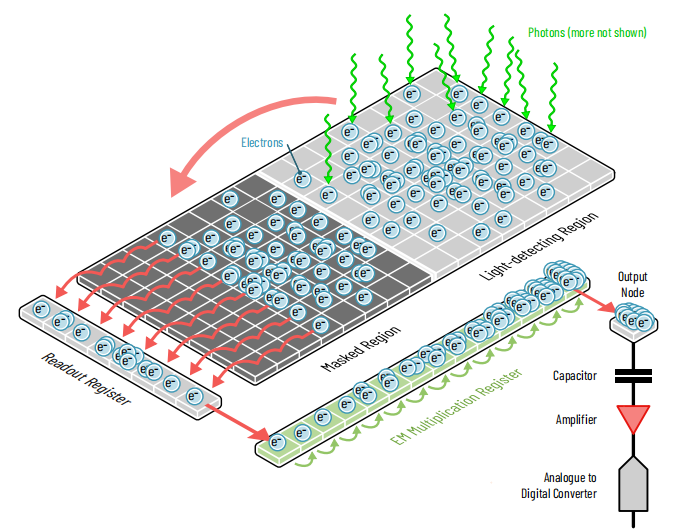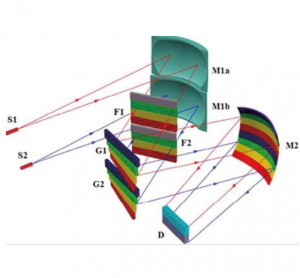The Electron-Multiplying CCD sensor is an evolution of the CCD sensor to allow lower light operation. They are typically intended for signals of a few hundred photoelectrons, down to the individual photon-counting level.
This article explains what EMCCD sensors are, how they function, their advantages and disadvantages, and why they are considered the next evolution of CCD technology for low-light imaging.
What Is an EMCCD Sensor?
An Electron-Multiplying Charge-Coupled Device (EMCCD) sensor is a specialized type of CCD sensor that amplifies weak signals before they are read out, allowing for extremely high sensitivity in low-light environments.
Initially developed for applications such as astronomy and advanced microscopy, EMCCDs can detect single photons, a task that traditional CCD sensors struggle with. This ability to detect individual photons makes EMCCDs crucial for fields requiring precise imaging under very low light levels.
How Do EMCCD Sensors Work?
Up to the point of readout, EMCCD sensors operate on the same principles as CCD sensors. However, before measurement with the ADC, detected charges are multiplied through a process called impactionization, in an ‘electron multiplication register’. Over a series of several hundred steps, the charges from a pixel are moved along a series of masked pixels at high voltage. Each electron at each step has a chance of bringing along additional electrons. The signal is therefore multiplied exponentially.
The end result of a well-calibrated EMCCD is the ability to choose a precise amount of average multiplication, typically around 300 to 400 for low-light work. This enables the signals detected to be multiplied far higher than the camera’s read noise, in effect reducing the read noise of the camera. Unfortunately, the stochastic nature of this multiplication process means each pixel is multiplied by a different amount, which introduces an additional noise factor, reducing the EMCCD's signal-to-noise ratio (SNR).
Here’s a breakdown of how EMCCD sensors operate. Until Step 6, the process is effectively the same as that for CCD sensors.

At the end of their exposure, EMCCD sensors first quickly move collected charges to a masked array of pixels the same dimensions as the light sensitive array (frame transfer). Then, one row at a time, charges are moved into a readout register. One column at a time, charges within the readout register are passed to a multiplication register. At each stage of this register (up to 1000 stages in real EMCCD cameras), every electron has a small chance to release an additional electron, multiplying the signal exponentially. At the end, the multiplied signal is read out.
1. Charge Clearing: To begin the acquisition, the charge is simultaneously cleared from the whole sensor (global shutter).
2. Charge Accumulation: Charge accumulates during exposure.
3. Charge Storage: After exposure, collected charges are moved to a masked area of the sensor, where they can await readout without new photons detected photons being counted. This is the 'Frame Transfer' process.
4. Next Frame Exposure: With the detected charges stored in the masked pixels, the active pixels can begin the exposure of the next frame (overlap mode).
5. Readout Process: One row at a time, charges for each row of the finished frame are moved into a 'readout register'.
6. One column at a time, charges from each pixel are shuttled into the readout node.
7. Electron Multiplication: Next, all electron charges from the pixel enter the electron multiplication register, and move along step by step, multiplying in number exponentially at each step.
8. Readout: The multiplied signal is read by the ADC, and the process is repeated until the entire frame is read out.
Pros and Cons of EMCCD Sensors
Pros of EMCCD Sensors
|
Advantage |
Description |
|
Photon Counting |
Detects individual photoelectrons with ultra-low read noise (<0.2e⁻), enabling single-photon sensitivity. |
|
Ultra-Low-Light Sensitivity |
Significantly better than traditional CCDs, sometimes surpassing even high-end sCMOS cameras at very low light levels. |
|
Low Dark Current |
Deep cooling reduces thermal noise, enabling cleaner images during long exposures. |
|
‘Half-Global’ Shutter |
Frame transfer allows near-global exposure with very fast charge shifting (~1 microsecond). |
● Photon Counting: With high enough electron multiplication, read noise can be practically eliminated (<0.2e-). This, alongside the high gain value and near-perfect quantum efficiency, means that distinguishing individual photoelectrons is possible.
● Ultra-Low-Light Sensitivity: Compared to CCDs, the low-light performance of EMCCDs is drastically better. There may be some applications where EMCCD provides better detection capability and contrast even than high-end sCMOS at the lowest possible light levels.
● Low Dark Current: As with CCDs, EMCCDs are typically deep cooled and able to deliver very low dark current values.
● 'Half Global' Shutter: The frame transfer process to start and end exposure is not truly simultaneous, but typically takes on the order of 1 microsecond.
Cons of EMCCD Sensors
|
Disadvantage |
Description |
|
Limited Speed |
Maximum frame rates (~30 fps at 1 MP) are much slower than modern CMOS alternatives. |
|
Amplification Noise |
The random nature of electron multiplication introduces excess noise, reducing SNR. |
|
Clock-Induced Charge (CIC) |
Fast charge movement can introduce false signals that get amplified. |
|
Reduced Dynamic Range |
High gain reduces the maximum signal the sensor can handle before saturating. |
|
Large Pixel Size |
Common pixel sizes (13–16 μm) may not align with many optical system requirements. |
|
Heavy Cooling Requirement |
Stable deep cooling is required to achieve consistent multiplication and low noise. |
|
Calibration Needs |
EM gain degrades over time (multiplication decay), requiring regular calibration. |
|
Short Exposure Instability |
Very brief exposures can cause unpredictable signal amplification and noise. |
|
High Cost |
Complex manufacturing and deep cooling make these sensors more expensive than sCMOS. |
|
Limited Lifespan |
The electron multiplication register wears out, typically lasting 5–10 years. |
|
Export Challenges |
Subject to strict regulations due to potential military applications. |
● Limited Speed: Fast EMCCDs provide around 30 fps at 1 MP, similar to CCDs, orders of magnitude slower than CMOS cameras.
● Noise Introduction: The 'excess noise factor' caused by the random electron multiplication, compared to a low-noise sCMOS camera with the same quantum efficiency, can give EMCCDs drastically higher noise depending on signal levels. SNR for high-end sCMOS is typically better for signals of around 3e-, even more so for higher signals.
● Clock-Induced Charge (CIC): Unless carefully controlled, movement of charges across the sensor can introduce additional electrons into pixels. This noise is then multiplied by the electron multiplication register. Higher charge movement speeds (clock rates) lead to higher frame rates, but more CIC.
● Reduced Dynamic Range: The very high electron multiplication values required to overcome the EMCCD read noise lead to much reduced dynamic range.
● Large Pixel Size: The smallest common pixel size for EMCCD cameras is 10 μm, but 13 or 16 μm is most common. This is far too large to match most optical systems’ resolution requirements.
● Calibration Requirements: The electron multiplication process wears out the EM register with use, reducing its ability to multiply in a process called ‘electron multiplication decay’. This means the gain of the camera is constantly changing, and the camera requires regular calibration to perform any quantitative imaging.
● Inconsistent Exposure at Short Times: When using very short exposure times, EMCCD cameras may produce inconsistent results because the weak signal gets overwhelmed by noise, and the amplification process introduces statistical fluctuations.
● Heavy Cooling Requirement: The electron multiplication process is strongly influenced by temperature. Cooling the sensor increases the available electron multiplication. Therefore deep sensor cooling while maintaining temperature stability is therefore critical to reproducible EMCCD measurements.
● High cost: The difficulty of manufacture of these multi-component sensors, combined with deep cooling, leads to prices typically higher than the highest quality sCMOS sensor cameras.
● Limited Lifespan: Electron multiplication decay puts a limit on the lifetime of these expensive sensors of usually 5-10 years, depending on the level of use.
● Export Challenges: The import and export of EMCCD sensors tends to be logistically challenging due to their potential use in military applications.
Why EMCCD Is the Successor to CCD
|
Feature |
CCD |
EMCCD |
|
Sensitivity |
High |
Ultra-high (especially low light) |
|
Readout Noise |
Moderate |
Extremely low (due to gain) |
|
Dynamic Range |
High |
Moderate (limited by gain) |
|
Cost |
Lower |
Higher |
|
Cooling |
Optional |
Typically required for optimal performance |
|
Use Cases |
General imaging |
Low-light, single-photon detection |
EMCCD sensors build on traditional CCD technology by incorporating an electron multiplication step. This enhances the ability to amplify weak signals and reduce noise, making EMCCDs the preferred choice for extremely low-light imaging applications where CCD sensors fall short.
Key Applications of EMCCD Sensors
EMCCD sensors are commonly used in scientific and industrial fields that require high sensitivity and the ability to detect faint signals:
● Life Science Imaging: For applications like single-molecule fluorescence microscopy and total internal reflection fluorescence (TIRF) microscopy.
● Astronomy: Used for capturing faint light from distant stars, galaxies, and exoplanet research.
● Quantum Optics: For photon entanglement and quantum information experiments.

● Forensics and Security: Employed in low-light surveillance and trace evidence analysis.
● Spectroscopy: In Raman spectroscopy and low-intensity fluorescence detection.
When Should You Choose an EMCCD Sensor?
With the improvements to CMOS sensors in recent years, the read noise advantage of EMCCD sensors has diminished as now even sCMOS cameras are capable of subelectron read noise, alongside a huge range of other benefits. If an application has previously used EMCCDs, it is well worth reviewing whether this is the best choice given developments in sCMOS.
Historically, EMCCDs could still perform photon counting more successfully, alongside a few other niche applications with typical signal levels less than 3-5e- per pixel at peak. Though, with larger pixel sizes and sub-electron read noise becoming available in scientific cameras based on sCMOS technology, it’s possible these applications too may soon be performed with high-end sCMOS.
FAQs
What Is the Minimum Exposure Time for Frame Transfer Cameras?
For all frame transfer sensors, including EMCCDs, the question of minimum possible exposure time is a complicated one. For single image acquisitions, the exposure can be ended by shuffling acquired charges into the masked region for readout very rapidly, and short (sub-microsecond) minimum exposure times are possible.
However, as soon as the camera is streaming at full speed, i.e.acquiring multiple frames / a movie at full frame rate, as soon as the first image finishes exposing, the masked region is occupied by that frame until readout is completed. The exposure can therefore not end. This means that, irrespective of the exposure time requested in software, the real exposure time of subsequent frames after the first of a full-speed multi-frame acquisition is given by the frame time, i.e. 1 / Frame Rate, of the camera.
Is sCMOS Technology Replacing EMCCD Sensors?
EMCCD cameras had two specifications that helped retain their advantage in extreme-lowlight imaging scenarios (with peak signal levels of 5 photoelectrons or less). Firstly, their large pixels, up to 16 μm, and secondly their <1e- read noise.
A new generation of sCMOS camera has emerged that offers these same characteristics, without the numerous drawbacks of EMCCDs, especially the excess noise factor. Cameras such as the Aries 16 from Tucsen offer 16 μm back-illuminated pixels with a read noise of 0.8e-. With low noise and ‘natively’ large pixels, these cameras also outperform most binned sCMOS cameras, due to the relationship between binning and read noise.
If you want to learn more about EMCCD, please click:


 2025/08/01
2025/08/01







